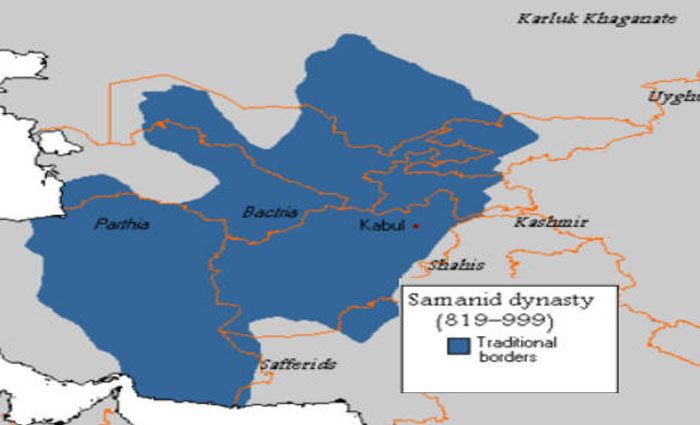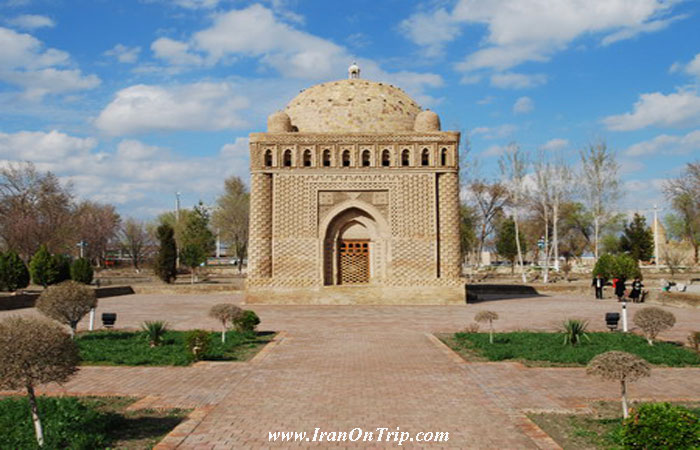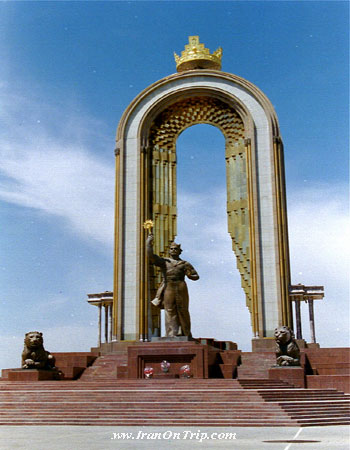Samanid Empire

The Samani dynasty (Persian: سامانیان, Tajik: Сомониён - Sāmāniyān), also known as the Samanid Empire, or simply Samanids (819–999), was a Sunni Persian Empire in Central Asia, named after its founder Saman Khuda, who converted to Islam despite being from Zoroastrian theocratic nobility. It was a native Persian dynasty in Greater Iran and Central Asia after the collapse of the Sassanid Persian empire caused by the Arab conquest.
Domination
The Samanids, a dynasty of Persian dehqan origin, reigned for 180 years, encompassing a territory which included Greater Khorasan (including Kabul), Ray, Transoxiania, Tabaristan, Kerman, Gorgan, and west of these provinces up to Isfahan. At the peak of their power, the Samanids controlled territory extending as far south as the Sulaiman Mountains in Quetta, Ghazni and Kandahar, and as far as Qazvin in the west. The Samanids were descendants of Bahram Chobin, and thus descended from the House of Mihrān, one of the Seven Great Houses of Iran. In governing their territory, the Samanids modeled their state organization after the Abbasids, mirroring the caliph's court and organization. They were rewarded for supporting the Abbasids in Transoxania and Khorasan, and with their established capitals located in Bukhara, Balkh, Samarkand, and Herat, they carved their kingdom after defeating the Saffarids.
With their roots stemming from the city of Balkh (then, part of Greater Khorasan) the Samanids promoted the arts, giving rise to the advancement of science and literature, and thus attracted scholars such as Rudaki, Ferdowsi, and Avicenna. While under Samanid control, Bukhara was a rival to Baghdad in its glory. Scholars note that the Samanids revived Persian more than the Buyids and the Saffarids, while continuing to patronize Arabic to a significant degree. Nevertheless, in a famous edict, Samanid authorities declared that "here, in this region, the language is Persian, and the kings of this realm are Persian kings.
History

The Mausoleum of Ismail the Samanid in Bukhara.
The Samanid Empire was the first native Persian dynasty to arise after the Muslim Arab conquest. The four grandsons of the dynasty's founder, Saman Khuda, had been rewarded with provinces for their faithful service to the Abbasid caliph al-Mamun: Nuh obtained Samarkand; Ahmad, Fergana; Yahya, Shash; and Elyas, Herat. Ahmad's son Nasr became governor of Transoxania in 875, but it was his brother and successor, Ismail Samani who overthrew the Saffarids and the Zaydites of Tabaristan, thus establishing a semiautonomous rule over Transoxania and Khorasan, with Bukhara as his capital. In 893, Ismail invaded and defeated the Karluk Turks, taking Talas and converting the Nestorian church there into a mosque. Ismail's son, Ahmad, sent two military excursions (911 & 912-913) into Sistan to re-establish Samanid control over the Caspian provinces.
The Samanids defeat the Saffarids and Zaydids
Samanid rule in Bukhara was not formally recognized by the caliph until the early 900s when the Saffarid ruler 'Amr-i Laith had asked the caliph for the investiture of Transoxiana. The caliph, Al-Mu'tadid however sent the Samanid amir, Ismail Samani, a letter urging him to fight Amr-i Laith and the Saffarids whom the caliph considered usurpers. According to the letter, the caliph stated that he prayed for Ismail who the caliph considered as the rightful ruler of Khorasan. The letter had a profound effect on Ismail, as he was determined to oppose the Saffarids.
The two sides fought in Balkh, (now modern-day Afghanistan), during the spring of 900. During the battle, Ismail was significantly outnumbered as he came out with 20,000 horsemen against Amr's 70,000 strong cavalry. Ismail's horsemen were ill-equipped with most having wooden stirrups while some had no shields or lances. Amr-i Laith's cavalry on the other hand, were fully equipped with weapons and armor. Despite fierce fighting, Amr was captured as some of his troops switched sides and joined Ismail. D. G. Tor suggests that the defections to the Samanid side were because of Ismail's raids into Central Asia had given him the reputation of being a successful holy warrior.Isma'il thereafter sent an army to Tabaristan in accordance with the caliph's directive. The area at that time was then controlled by the Zaydids. The Samanid army defeated the Zaydid ruler Muhammad ibn Zayd and the Samanids gained control of the region
Cultural and religious efforts
The Samanids revived Persian culture by patronizing Rudaki, Bal'ami and Daqiqi. They also determinedly propagated Sunni Islam. However, the Samanids repressed Ismaili Shiism but were more tolerant of Twelver Shiism. Islamic architecture and Islamo-Persian culture was spread deep into the heart of Central Asia by the Samanids. Following the first complete translation of the Qur'an into Persian, during the 9th century, populations under the Samanid empire began accepting Islam in significant numbers.
Through zealous missionary work as many as 30,000 tents of Turks came to profess Islam and later under the Ghaznavids more than 55,000 under the Hanafi school of thought. The mass conversion of the Turks to Islam eventually led to a growing influence of the Ghaznavids, who would later rule the region.Agriculture and trading were the economic basis of Samanid State. The Samanids were heavily involved in trading - even with Europe, as thousands of Samanid coins that have been found in the Baltic and Scandinavian countries testify.Another lasting contribution of the Samanids to the history of Islamic art is the pottery known as Samanid Epigraphic Ware: plates, bowls, and pitchers fired in a white slip and decorated only with calligraphy, often elegantly and rhythmically written. The Arabic phrases used in this calligraphy are generally more or less generic well wishes, or Islamic admonitions to good table manners.
Decline and fall

Monument of Amir Ismail Samani in Tajikistan
The power of the Samanids began to crumble in the latter half of the 10th century. In 962, one the ghulams, Alp Tigin, commander of the army in Khurasan, seized Ghazna and established himself there. His successors, however, including Sebük Tigin, continued to rule as Samanid "governors". With the weakened Samanids facing rising challenges from the Karakhanids for control of Transoxania, Sebük later took control of all the provinces south of the Oxus and established the Ghaznavid Empire.
In 992, a Karakhanid, Harun Bughra Khan, grandson of the paramount tribal chief of the Karluk confederation Sultan Satuq Bughra Khan, captured Bukhara, the Samanid capital. Harun died shortly afterwards, however, and the Samanids returned to Bukhara. In 999, Nasr b. Ali, a nephew of Harun, returned and took possession of Bukhara, meeting little resistance. The Samanid domains were split up between the Ghaznavids, who gained Khorasan and Afghanistan, and the Karakhanids, who received Transoxania; the Oxus River thus became the boundary between the two rival empires. The Samanid Isma'il II al-Muntasir escaped from Karakhanid captivity and attempted to restore the Samanid dynasty, but he was killed by an Arab bedouin chieftain in 1005.
Legacy
In commending the Samanids, the epic Persian poet Ferdowsi says of them:
کجا آن بزرگان ساسانیان
ز بهرامیان تا به سامانیان
"Where have all the great Sassanids gone?
From the Bahrāmids to the Samanids what has come upon?"
According to a Bukharian historian writing in 943 stated that Ismail Samani:
"was indeed worthy and right for padishahship. He was intelligent, just, compassionate person, one possessing reason and prescience...he conducted affairs with justice and good ethics. Whoever tyrannized people he would punish...In affairs of state he was always impartial."
The celebrated scholar Nizam al-Mulk, in his famous work, Siyasatnama, stated that Ismail Samani:
"was extremely just, and his good qualities were many. He had pure faith in God (to Him be power and glory) and he was generous to the poor - to name only one of his notable virtues.The Somoni currency of Tajikistan is named after the Samanids. A notable airline based in Dushanbe is also named Somon Air. Also, the highest mountain in Tajikistan and in the former Soviet Union is named after Ismail Samani. The mountain was formerly known as "Stalin Peak" and "Communism Peak" but was subsequently changed to the Ismoil Somoni Peak.
.....
.....
.....

.jpg)



























